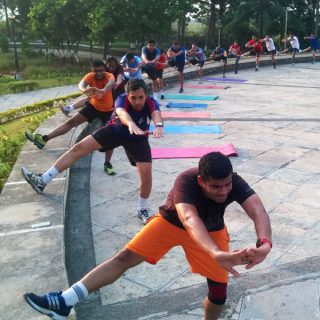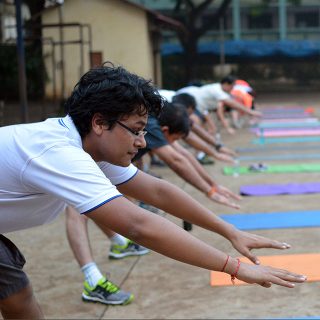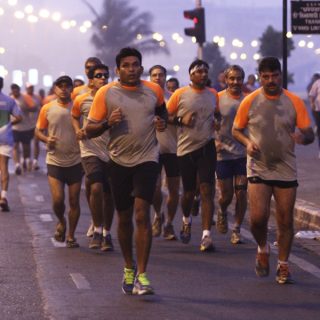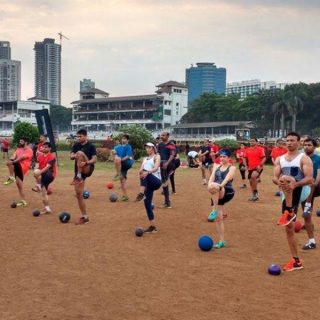FREQUENTLY ASKED QUESTIONS
Running & Training
- 1. What is anaerobic threshold? How does it affect my running?
- 2. What is VO2 max?
- 3. What is the difference between Strength and Weight training?
- 4. How do I increase my running speed?
- 5. What can I do to in substitute of a hill workout?
Anaerobic threshold is a very powerful and reliable tool in boosting one’s performance in aerobic exercise. It is related to the intensity of your exercise. It is the level at which lactic acid builds in the body. Increased lactic acid levels slow you down.
By increasing your anaerobic threshold, you can improve your efficiency and endurance, so you will be able to run longer and at a higher intensity.

V = Volume, O2 = Oxygen. Max = Maximum, thus VO2 max is the maximum volume of oxygen an individual utilizes for a particular exercise at its maximum intensity. It is generally used to identify an individual’s athletic cardio vascular fitness & aerobic endurance.

Strength training improves the overall health and fitness levels of an individual whereas weight training pertains to building muscles. Strength training concentrates on building bone density, fighting obesity, raising the metabolism and keeping the heart healthy. Weight training also incorporates strength training, but only for promoting muscle growth.

Your running speed can be increased by increasing the intensity of your exercise regime and increasing your cardio vascular endurance. Strength training, right posture and adequate nutrition will also help you to run fast and stay fit.

Many people consider running stadium stairs an alternative for a hill workout. If you do not have access to a stadium in your vicinity, you can replicate the activity by running your apartment stairs.

Shoes & Other Kit
- 1. I am a beginner runner. What kind of shoes would I need?
- 2. What is the difference between a pronator, an overpronator and a supinator?
- 3. What is the best cushioning?
- 4. How to find out if I am a overpronator or a supinator?
- 5. What are the categories of running shoes?
- 6. Should I adopt barefoot running?
For a beginner, it is important to find a shoe, which matches your foot type and gait. Your shoes should be well cushioned and have a perfect fit. Beginners need to protect their feet by wearing comfortable and cushioned shoes.

Pronation and supination are both natural positions of your foot, necessary for you to walk or run. Pronation is required to absorb the shock resulting from contact with the ground, whereas supination is the opposite of pronation and is required for pushing off in the running or walking gait.
Everyone pronates and supinates; the problem only occurs when one pronates too much or too little. An individual who is inclined to pronate too much is called an overpronator, and too little, a supinator.

The cushioning in a shoe helps the body’s natural shock absorbers to reduce the impact exerted on the foot while running. There is no universal ideal cushioning, as its requirements vary from person to person. Many shoes have cushions at the heel and the forefoot.

Generally, people with flat feet tend to overpronate, while people with high arches tend to supinate.
Best way is to check the soles of your current running shoes. If you were an overpronator, the outer sole of your shoes would be worn out along the inside, near the ball of the foot. If you were a supinator, the outer sole of your shoes would be worn out along the outer edge.
Alternatively, you could monitor your gait. You are:
- A pronator – if the arch of your foot flattens, when your foot strikes the ground.
- An overpronator – if you have a flat or a weak arch and your feet roll inward too much. It can lead to injuries and needs to be rectified.
- A supinator – if you more often than not stand on the outside border of your foot.

The three major categories of running shoes are:
- Motion control shoes for over pronators
- Cushioned shoes for supinators
- Stability shoes for pronators

Barefoot running has its share of advantages and disadvantages. The important thing to consider while running barefoot as well as with shoes is to ensure you follow proper technique for your safety.

Nutrition
- 1. Do I need to follow a special diet for training for a half marathon?
- 2. What is the best food to eat after my daily training?
- 3. What kind of diet should I follow on my rest days?
- 4. Do I need to eat during my long runs?
- 5. What food should I avoid before and after my runs?
Meeting your nutritional requirements is important whether you are training for a half marathon or not. But yes, you will need to follow a special diet while training for a half marathon, because your body needs additional nutrients when you transition from running for hobby to running for competition.
You will have to increase your carbohydrate consumption for increased energy supply, along with a proportionate intake of proteins (for repair & re-growth), fat (for protection of vital organs), vitamins and minerals, especially calcium. Fruits and vegetables are the best sources of vitamins and minerals.

Your body needs to recover and stay strong after your daily training sessions. Proteins will help in muscle recovery and carbohydrates will give you strength for your next session.

Your body recovers when you rest. You need to fuel your body on rest days to help muscle recovery and growth. A balanced diet on your rest days without concentrating on increasing your carbohydrate or protein intake would be ideal.

It is important to stay hydrated during long runs. Remember to keep electrolytes handy. Solid food items, which are high in carbohydrates and easy to digest, can be consumed during long runs.

You need to avoid fried food and products having high fat content both before and after long runs. High fiber food should be avoided before a long run, as it can affect your digestive system. Avoid salty snacks and high sugar content food items post your run.

Physiotherapy
- 1. I suffered an injury due to which I had to stop running. Now I am returning to running after 6 months. How should I train?
- 2. I have been diagnosed with Runner’s Knee. How soon can I start training for marathon?
- 3. What is a stress fracture? Can one run through it?
- 4. How can I prevent hamstring injuries?
Start with slow walks. They will help you in base building. Slow walks will help your muscle tissues to get adapted with physical activity. Gradually, increase your walking intensity and transition towards running. Once you feel comfortable, opt for strength and flexibility training.

Runner’s knee results in striking pain. You are the best judge of your pain and recovery. You can start your training at a low intensity. If you do not feel any pain or uneasiness around your knee, then you can increase your training intensity. Consult your doctor and make sure that you allow your tissues to recover and be patient with your training. Start small and go slow.

A stress fracture occurs because of a crack in the bone. The crack does not go completely through the bone; it occurs as a result of repeated stress on it. Stress fractures cause pain in a focused area and running aggravates it. Usually, it takes four to six weeks to recover from a stress fracture. It would be best to consult with your physiotherapist before running again.

Hamstring occurs when muscles are in a static, shortened position or are overworked. Avoid sitting in the same position for a long time – stand up and walk quite often. Make sure to stretch before and after your workout to avoid hamstring injuries.

